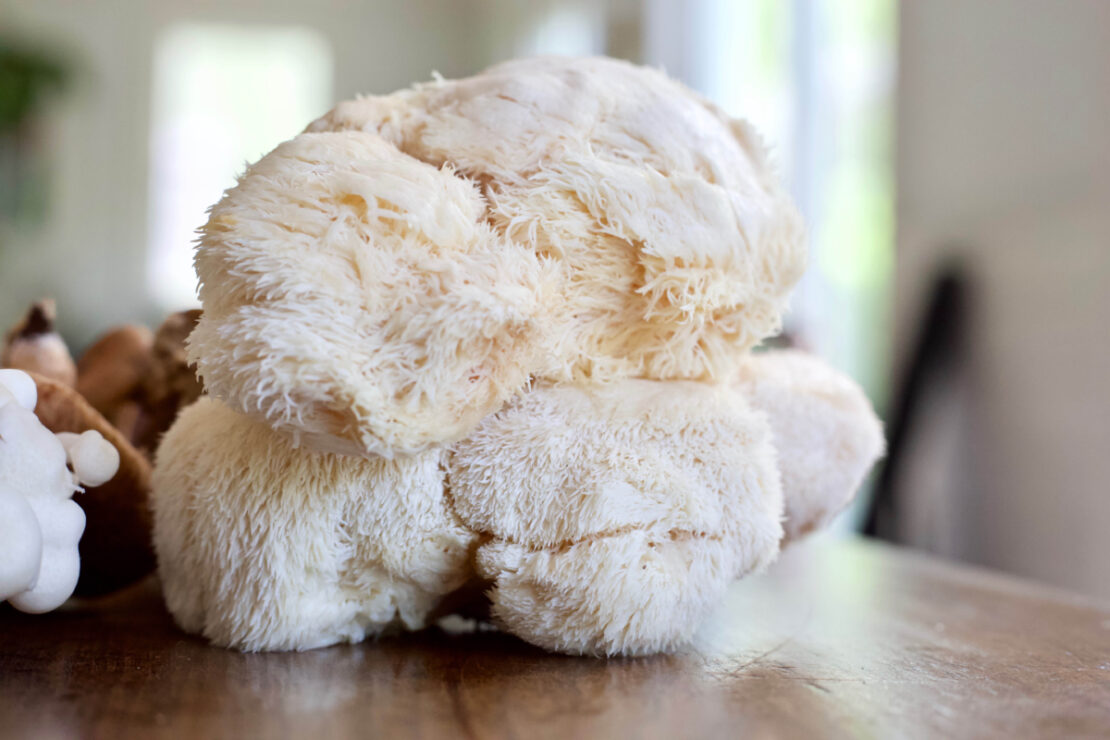
Lion’s Mane Mushroom: What You Should Know
For many years, mushrooms have received most of their attention as a popular pizza topping. But recently, these members of the fungi kingdom are getting a lot of spotlight as a “superfood” and functional mushrooms, like lion’s mane (Hericium erinaceus), are becoming increasingly popular.
These days mushrooms are being studied for their wellness properties and are consumed not just as nutritional food, but also as nutraceuticals, food supplements that have wellness benefits (Sabaratnam et al., 2013). The average consumer is also becoming more aware of the health benefits of different mushroom species.
While many of the edible varieties of mushrooms have health benefits, a few have stand out qualities. Lion’s mane (Hericium erinaceus) has been getting special attention for its potential benefits of supporting nerve regeneration and brain health (Sabaratnam et al., 2013).
I don’t know about you, but as I am aging, and also as a mother, I am finding I need all the brain power I can get! So I’m very interested in supporting my mental capacity and keeping my nervous system nourished. In this article, we will discuss the benefits of lion’s mane mushroom and the best sources of this fungi powerhouse.
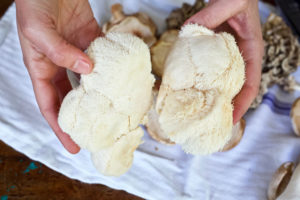
What is Lion’s Mane?
Lion’s mane, historically known as an edible mushroom, was given its name due to its white, fluffy, cascading white spines (Stamets, 2005) resembling the long tresses of a lion. Hericium erinaceus grows in a formation that resembles a giant snowball and is sometimes referred to as monkey’s head, old man’s beard, hedgehog mushroom, pom pom (Stamets, 2005), and yamabushitake, a Japanese word that translates as “those who sleep in the mountains” (Rogers, 2011).
Lion’s mane is most abundantly found in the southern regions of the United States but has also been reported in other areas of North America, as well as Europe, China, and Japan (Stamets, 2005).
In the wild, lion’s mane can grow up to 40 cm in diameter (Stamets, 2005). This fungus does not have the same appearance as your typical mushroom, with no stalk or cap. Its white, cascading spines grow downward in a fork, changing color to brown or yellowish-brown with age (Stamets, 2005). If you were to encounter this white, spiny fungus in its natural habitat, it would likely be growing on dying or dead oak, walnut, beech, maple, or sycamore stumps or logs (Stamets, 2005).
Previously, mushrooms were considered to be part of the plant kingdom, but now they carry their own distinction as members of the kingdom of fungi. Mushrooms are usually recognized by their fruiting bodies, which is the part that we see with our naked eye; however, most of the magic occurs under the surface or at a cellular level with the mycelium. The mycelium is a web of cells called hyphae that is usually hidden in the soil or tree bark (Utah State University, n.d.). This web travels throughout a multitude of habitats, taking with it nutrients from soils, plants, and other organisms, to ultimately cycle nutrients through the food chain (Stamets, 2005). I recently enjoyed reading this sweet poem about the beauty of mushrooms:
“Without leaves, without buds, without flowers;
Yet they form fruit.
As a food, as a tonic, as a medicine;
The entire creation is precious” (Chang & Miles, 1989, p. 345).
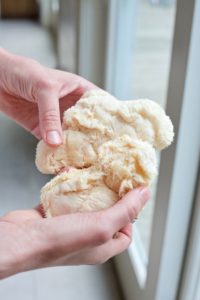
Benefits of Lion’s Mane
As mentioned, lion’s mane is most recognized for its important work in supporting brain function, memory, and mood. Many studies have been conclusive that lion’s mane can assist individuals with mental focus and retaining knowledge, and even support degenerative diseases, such as Alzheimer’s disease, by stimulating nerve growth factor (NGF) (Chong et al., 2019). Nerve growth factor is a family of proteins that maintain and assist in the growth and regeneration of neurons during our adult life (Sabaratnam et al., 2013). In a 2013 study published in the International Journal of Medicinal Mushrooms, the interaction between Hericium erinaceus and NGF was studied and was found to induce the synthesis of NGF cells and promote brain neurite outgrowth activity in vitro (Lai et al., 2013).
As humans age, certain cognitive functions start to decline, and we begin to lose our ability to form connections in the brain, learn new skills, retain information, and recall memories (Burke & Barnes, 2006). Lion’s mane is a powerful brain tonic and has increasingly been studied for its neuroprotective properties (Zhang et al., 2016). As world-renowned mycologist and author Paul Stamets says, “Lion’s mane may be our first ‘smart’ mushroom. It is a safe, edible fungus that appears to confer cognitive benefits on our aging population” (Stamets, 2017, para 16).
In a 2009 double-blind, placebo-controlled clinical trial in Japan, 50-80-year-old men with mild cognitive impairment were given four 250 mg tablets containing 96% lion’s mane powder three times a day for 16 weeks (Mori et al., 2009). The results of this study showed marked improvement on the cognitive function tests compared with the placebo group, concluding that lion’s mane may be effective in improving mild cognitive impairment in humans (Mori et al., 2009).
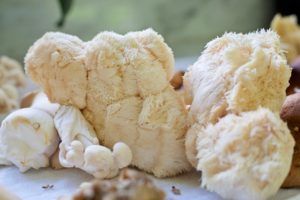
In our fast-paced society, I think most people would benefit from reduced stress and increased peace or happiness overall. Many studies are finding that consuming lion’s mane can be helpful not only for supporting brain health, but also for easing anxiety and depression (Nagano et al., 2010).
Depression is a common and serious illness with broad impacts across the globe (Chong et al., 2019). The effects of lion’s mane on brain function may also prove to be beneficial in supporting those who suffer from depression and anxiety. In a 2010 study, 30 post-menopausal women who consumed lion’s mane in a controlled dose baked into cookies over a period of 4 weeks showed less anxiety and depression and also showed improvement in mental focus (Nagano et al., 2010). Even though there have not yet been many studies to date utilizing lion’s mane as an alternative for the treatment of depression (Chong et al., 2019), we can be hopeful that more research will be done in this area in the future. Lion’s mane may help calm our nervous system and make us feel happier overall (Nagano et al., 2010).
In addition to all of its cognitive and mood-enhancing benefits, lion’s mane also has significant nutritional value. Hericium erinaceus is composed of protein, carbohydrates, fiber, fats, amino acids, as well as many vitamins and minerals (Bacha et al., 2018). Lion’s mane has also been used in Traditional Chinese Medicine as a digestive tonic for thousands of years (Stamets, 2005).
As most fungi do, lion’s mane also contains a particular type of complex branched-chain polysaccharides called beta glucans. Beta glucans make lion’s mane an excellent choice for boosting immune health (Hobbs, 1986). In fact, the polysaccharides found in fungi are similar to the ones found in more commonly recognized immune-supporting herbs such as echinacea (Echinacea spp.) and astragalus (Astragalus membranaceus) (Hobbs, 1986). Complex polysaccharides found in herbs and mushrooms can also aid in imbalances with blood pressure, cholesterol, ulcers, cancer, diabetes, liver problems, and more (Bacha et al., 2018).
While the possibility of lion’s mane providing support for many imbalances of the body and mind is quite exciting, currently most of the research on the benefits of lion’s mane has been performed on animals. As we find more evidence that lion’s mane can help boost mental function, we can assume that more studies will be done with humans as well. Although more research stands to be done on the side effects of lion’s mane, aside from a case of reported respiratory distress linked with the consumption of lion’s mane extract (Nakatsugawa et al., 2003), it has been found to have very few side effects and is considered safe (Zhang et al., 2016). However, if you are allergic or have a sensitivity to mushrooms, avoid ingesting lion’s mane in any form.
Where to Find Lion’s Mane Mushroom
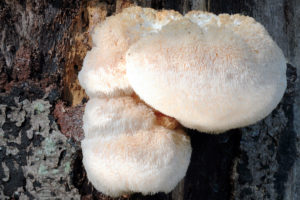
Previously, lion’s mane was only accessible if you knew how to forage it or if you were an experienced mushroom grower. Recently, though, it has become more widely available in many gourmet grocery stores, on the shelves of the supplement or vitamin aisles in many health food stores, and even at farmers markets!
Mushroom Foraging
If you are feeling adventurous, you can try foraging for lion’s mane in the hardwood forests of North America, Europe, and Asia during the summer and fall (Stamets, 2017). A word of caution when foraging for mushrooms! Always ensure that you positively identify any mushroom you find before consuming it.
Grow Your Own
If you are feeling up to the challenge, another option is to try growing your own lion’s mane mushrooms at home. Growing your own mushrooms is a mindful ecological choice, as it is always best to do what we can to protect our wildlife species and eat locally! If this sounds intimidating to you, there are many sources available to the inexperienced mushroom grower.
Mushroom growing is gaining popularity as a hobby, so much so that you can even find easy DIY mushroom growing kits readily available at your local grocer or online. I was able to find a source to purchase a lion’s mane growing kit on NorthSpore. These kits usually contain a colonized mushroom fruiting block made of sawdust, so the hard work has mostly been done for you.
Checking your local farmers market for growing kits is also another great possibility as many mushroom growers are sharing their love of mushrooms and empowering others to grow at home. If you are local to San Diego, a great source for a budding mushroom grower is SoulFungi. You can view their available kits and contact them to pick up a kit if you are in the area!
If you do find yourself with a fluffy, white head of lion’s mane, whether from the wild or one you’ve grown at home, you can follow directions from Freshcap Mushrooms on how to harvest it.
Ways to Reap the Benefits of Lion’s Mane
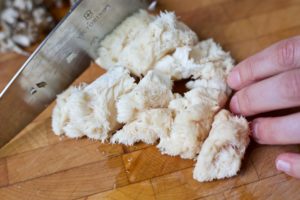
Cooking with Mushrooms
As with most plants and fungi, using fresh mushrooms is usually considered best!
Because lion’s mane mushrooms are now sold more frequently at gourmet food chains, many people are choosing to prepare these mushrooms at home more often. Lion’s mane mushroom has a mild flavor, with a texture somewhat resembling lobster or shrimp.
Lion’s mane tastes best sautéed in butter (like most mushrooms), but it is also tasty when deglazed with saké or white wine or stir-fried with sherry vinegar and shallots. Popular uses of lion’s mane include soups, side dishes, and stir-fries.
Many vegetarians find that lion’s mane can be a good substitute for meat or seafood in various dishes, as its spongy consistency soaks up the flavor of what it’s cooked with. Lion’s mane is also becoming a popular choice in vegetarian crab cakes, as the taste is so similar. Here is a recipe for lion’s mane crab cakes if you want to give it a try.
For more tips on cooking with mushrooms, visit this post on our blog: Cooking With Edible Mushrooms: A Beginner’s Guide.
Using Mushroom Supplements
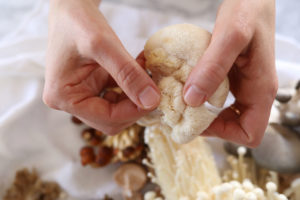
Although I am in favor of consuming fresh lion’s mane as a food, it is also widely available in extracts, pills, or powdered form. When deciding where to purchase lion’s mane supplements, be mindful of a company’s practices and ensure they are extracting both the whole fruiting body of the mushroom and mycelium in order to capture the entire nutrient profile of the fungus.
For proper dosing, please follow the instructions on the preparation you choose. Generally, the recommended dose for powdered lion’s mane is 2-5 grams a day (Powell, 2014). In an extract form, 1-3 mL (1:3 in 60% for fresh fruiting body, or 1:5 in 40% for dried) can be used as well (Rogers, 2011). However, when incorporating any new supplement into your diet, starting gradually is usually best. We suggest starting at 1 gram daily and adjusting your dosage slowly from there.
One of my favorite ways to take lion’s mane is to add it into my morning coffee blend. To my excitement, Four Sigmatic brand has created a blend that is just that—coffee and lion’s mane together to make it even easier to kick-start your day!
I also enjoy adding lion’s mane powder to my smoothies before I sit down at my desk to write for the day. I like to use a mushroom superfood supplement powder from Om or add the extract to my tea. If neither of those options sound appealing to you, Host Defense, owned by Paul Stamets, also sells powdered lion’s mane as a supplement in capsule form. Remember that with some supplementation routines, it takes time before you see results. Start your lion’s mane regimen today, and before you realize it, you’ll be feeling the effects of this powerful brain-boosting mushroom.

Try Lion’s Mane Today
As you can see, there is so much to know about lion’s mane mushroom! I personally have seen the positive effects of adding this marvelous mushroom to my diet, and I am thrilled to gain a better understanding as we continue to discover more about this shaggy little mushroom and what it can do to give us more clarity, focus, and keep us feeling more peaceful and content.
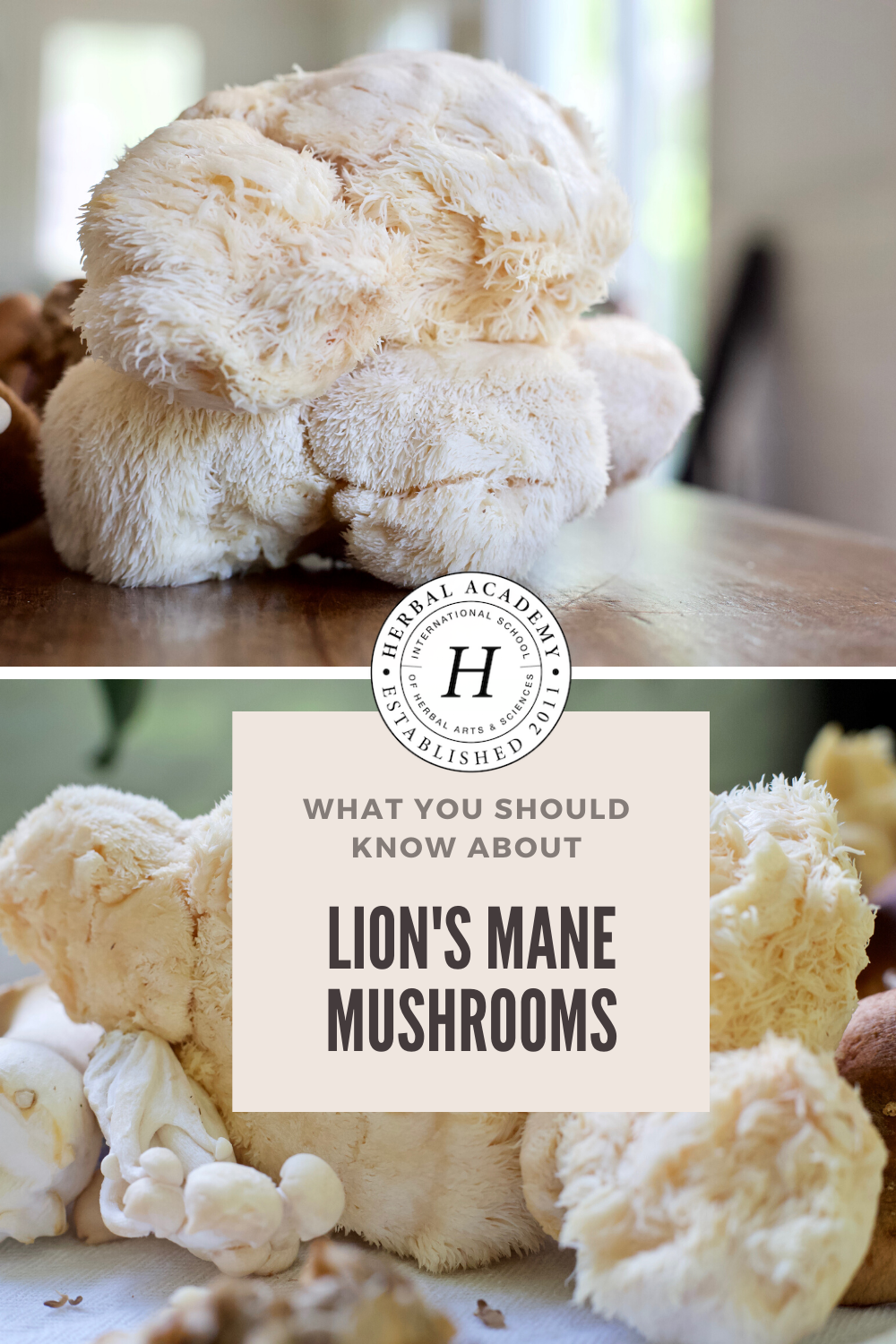
REFERENCES
Bacha, S.A.S., Shujaat, A., Li, Y., Rehman, H.U., Farooq, S., Mushtaq, A., & Wahocho, S. (2018). Lion’s mane mushroom; New addition to food and natural bounty for human wellness: A review [Abstract]. International Journal of Biosciences, 13(4), 396-402. Retrieved from http://www.innspub.net/wp-content/uploads/2018/10/IJB-Vol-13-No-4-p-396-402.pdf
Burke, S.N., & Barnes, C.A. (2006). Neural plasticity in the ageing brain. Nature Reviews Neuroscience, 7(1), 30–40. https://doi.org/10.1038/nrn1809
Chang, S.T., & Miles, P.G. (1989). Edible mushrooms and their cultivation. Boca Raton, FL: CRC Press.
Chong, P.S., Fung, M., Wong, K.H., & Lim, L.W. (2019). Therapeutic potential of Hericium erinaceus for depressive disorder. International Journal of Molecular Sciences, 21(1), 163. https://doi.org/10.3390/ijms21010163
Hobbs, C. (1986). Medicinal mushrooms. [Online Article]. Retrieved from https://www.christopherhobbs.com/library/featured-articles/mushroom-articles/
Lai, P., Naidu, M., Sabaratnam,V., Wong, K., David, R.P., Kuppusamy, U.R., … Malek, S.N.A. (2013). Neurotrophic properties of the lion’s mane medicinal mushroom, Hericium erinaceus (higher basidiomycetes) from Malaysia. International Journal of Medicinal Mushrooms, 15(6), 539–554. https://doi.org/10.1615/intjmedmushr.v15.i6.30
Mori, K., Inatomi, S., Ouchi, K., Azumi, Y., & Tuchida, T. (2009). Improving effects of the mushroom yamabushitake (Hericium erinaceus) on mild cognitive impairment: A double-blind placebo-controlled clinical trial. Phytotherapy Research, 23(3), 367–372. https://doi.org/10.1002/ptr.2634
Mori, K., Obara, Y., Moriya, T., Inatomi, S., & Nakahata, N. (2011). Effects of Hericium erinaceus on amyloid β(25-35) peptide-induced learning and memory deficits in mice. Biomedical Research, 32(1), 67–72. https://doi.org/10.2220/biomedres.32.67
Nagano, M., Shimizu, K., Kondo, R., Hayashi, C., Sato, D., Kitagawa, K., & Ohnuki, K. (2010). Reduction of depression and anxiety by 4 weeks Hericium erinaceus intake. Biomedical Research, 31(4), 231–237. https://doi.org/10.2220/biomedres.31.231
Nakatsugawa, M., Takahashi, H., Takezawa, C., Nakajima, K., Harada, K., Sugawara, Y., … Abe, S. (2003). Hericium erinaceum (yamabushitake) extract-induced acute respiratory distress syndrome monitored by serum surfactant proteins. Internal Medicine, 42(12), 1219–1222. https://doi.org/10.2169/internalmedicine.42.1219
Powell, M. (2014). Medicinal mushrooms: A clinical guide (2nd ed.). Dorset, UK: Mycology Press.
Rogers, R. (2011). The fungal pharmacy: The complete guide to medicinal mushrooms and lichens of North America. Berkeley, CA: North Atlantic Books.
Sabaratnam, V., Kah-Hui, W., Naidu, M., & David, P.R. (2013). Neuronal health – Can culinary and medicinal mushrooms help? Journal of Traditional and Complementary Medicine, 3(1), 62–68. https://doi.org/10.4103/2225-4110.106549
Stamets, P. (2005). Mycelium running: How mushrooms can help save the world. Berkeley, CA: Ten Speed Press.
Stamets, P. (2017). Lion’s mane: A mushroom that improves your memory and mood? [Online Article]. Retrieved from https://www.huffpost.com/entry/mushroom-memory_b_1725583?guccounter=1
Utah State University. (n.d.). What are fungi? [Online Article]. Retrieved from https://herbarium.usu.edu/fun-with-fungi/what-are-fungi
Wang, G., Zhang, X., Maier, S.E., Zhang, L., & Maier, R.J. (2019). In vitro and in vivo inhibition of Helicobacter pylori by ethanolic extracts of lion’s mane medicinal mushroom, Hericium erinaceus (Agaricomycetes). International Journal of Medicinal Mushrooms, 21(1), 1–11. https://doi.org/10.1615/intjmedmushrooms.2018029487
Zhang, J., An, S., Hu, W., Teng, M., Wang, X., Qu, Y., … Wang, D. (2016). The neuroprotective properties of Hericium erinaceus in glutamate-damaged differentiated PC12 cells and an Alzheimer’s disease mouse model. International Journal of Molecular Sciences, 17(11), 1810. https://doi.org/10.3390/ijms17111810








